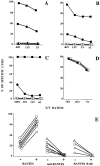HIV-specific T cell cytotoxicity mediated by RANTES via the chemokine receptor CCR3
- PMID: 9687538
- PMCID: PMC2212468
- DOI: 10.1084/jem.188.3.609
HIV-specific T cell cytotoxicity mediated by RANTES via the chemokine receptor CCR3
Abstract
CC chemokines produced by CD8(+) T cells are known to act as HIV-suppressive factors. We studied the possible role of these chemokines in HIV-1-specific killing of target cells. We found that the activity of cytotoxic T lymphocytes (CTLs) in CTL lines or freshly isolated peripheral blood mononuclear cells from HIV-1-infected individuals is markedly enhanced by RANTES (regulated on activation, normal T cell expressed and secreted) and virtually abolished by an antibody neutralizing RANTES or the RANTES receptor antagonist RANTES(9-68). Lysis was mediated by CD8(+) major histocompatibility complex class I-restricted T cells and was obtained with target cells expressing epitopes of the HIV-1LAI proteins Gag, Pol, Env, and Nef. The cytolytic activity observed in the presence or absence of added RANTES could be abolished by pretreatment of the CTLs with pertussis toxin, indicating that the effect is mediated by a G protein-coupled receptor. The chemokines monocyte chemotactic protein (MCP)-3, MCP-4, and eotaxin acted like RANTES, whereas macrophage inflammatory protein (MIP)-1alpha, MIP-1beta, MCP-1, and stromal cell-derived factor 1 were inactive, suggesting a role for the eotaxin receptor, CCR3, and ruling out the involvement of CCR1, CCR2, CCR5, and CXCR4. CTL activity was abrogated by an antibody that blocks CCR3, further indicating that specific lysis is triggered via this chemokine receptor. These observations reveal a novel mechanism for the induction of HIV-1-specific cytotoxicity that depends on RANTES acting via CCR3.
Figures




Similar articles
-
LPS induces eosinophil migration via CCR3 signaling through a mechanism independent of RANTES and Eotaxin.Am J Respir Cell Mol Biol. 2001 Dec;25(6):707-16. doi: 10.1165/ajrcmb.25.6.4401. Am J Respir Cell Mol Biol. 2001. PMID: 11726396
-
High expression of the chemokine receptor CCR3 in human blood basophils. Role in activation by eotaxin, MCP-4, and other chemokines.J Clin Invest. 1997 Sep 1;100(5):1137-43. doi: 10.1172/JCI119624. J Clin Invest. 1997. PMID: 9276730 Free PMC article.
-
Natural truncation of RANTES abolishes signaling through the CC chemokine receptors CCR1 and CCR3, impairs its chemotactic potency and generates a CC chemokine inhibitor.Eur J Immunol. 1998 Apr;28(4):1262-71. doi: 10.1002/(SICI)1521-4141(199804)28:04<1262::AID-IMMU1262>3.0.CO;2-G. Eur J Immunol. 1998. PMID: 9565366
-
Co-receptor use by HIV and inhibition of HIV infection by chemokine receptor ligands.Immunol Rev. 2000 Oct;177:112-26. doi: 10.1034/j.1600-065x.2000.17719.x. Immunol Rev. 2000. PMID: 11138769 Review.
-
Platelet chemokines and their receptors: what is their relevance to platelet storage and transfusion practice?Transfus Med. 2001 Dec;11(6):403-17. doi: 10.1046/j.1365-3148.2001.00340.x. Transfus Med. 2001. PMID: 11851938 Review.
Cited by
-
Inhibition of indoleamine 2,3-dioxygenase (IDO) enhances elimination of virus-infected macrophages in an animal model of HIV-1 encephalitis.Blood. 2005 Oct 1;106(7):2382-90. doi: 10.1182/blood-2005-04-1403. Epub 2005 Jun 16. Blood. 2005. PMID: 15961516 Free PMC article.
-
A role for the CCR5-CCL5 interaction in the preferential migration of HSV-2-specific effector cells to the vaginal mucosa upon nasal immunization.Mucosal Immunol. 2019 Nov;12(6):1391-1403. doi: 10.1038/s41385-019-0203-z. Epub 2019 Sep 24. Mucosal Immunol. 2019. PMID: 31551493
-
Combination of CCR5 and CXCR4 inhibitors in therapy of human immunodeficiency virus type 1 infection: in vitro studies of mixed virus infections.J Virol. 2000 Oct;74(19):9328-32. doi: 10.1128/jvi.74.19.9328-9332.2000. J Virol. 2000. PMID: 10982382 Free PMC article.
-
Immunization with live attenuated simian immunodeficiency virus induces strong type 1 T helper responses and beta-chemokine production.Proc Natl Acad Sci U S A. 1999 Nov 23;96(24):14031-6. doi: 10.1073/pnas.96.24.14031. Proc Natl Acad Sci U S A. 1999. PMID: 10570193 Free PMC article.
-
The influence of macrophage inflammatory protein-1alpha on protective immunity mediated by antiviral cytotoxic T cells.Immunology. 2003 May;109(1):68-75. doi: 10.1046/j.1365-2567.2003.01636.x. Immunology. 2003. PMID: 12709019 Free PMC article.
References
-
- Autran B, Hadida F, Haas G. Evolution and plasticity of CTL responses against HIV. Curr Opin Immunol. 1996;8:546–553. - PubMed
-
- Gotch FM, Nixon DF, Alp N, McMichael AJ, Borysievicz LK. High frequency of memory and effector Gag-specific cytotoxic T lymphocytes in HIV seropositive individuals. Int Immunol. 1990;2:707–712. - PubMed
-
- Hoffenbach A, Langlade-Demoyen P, Vilmer E, Dadaglio G, Michel F, Mayaud C, Autran B, Plata F. Very high frequencies of HIV specific cytotoxic T lymphocytes in humans. J Immunol. 1989;142:452–456. - PubMed
-
- Joly P, Guillon JM, Mayaud C, Plata F, Theodorou I, Denis M, Debré P, Autran B. Cell mediated suppression of HIV-specific cytotoxic T lymphocytes. J Immunol. 1989;143:2193–2201. - PubMed
Publication types
MeSH terms
Substances
LinkOut - more resources
Full Text Sources
Medical
Research Materials
Miscellaneous

